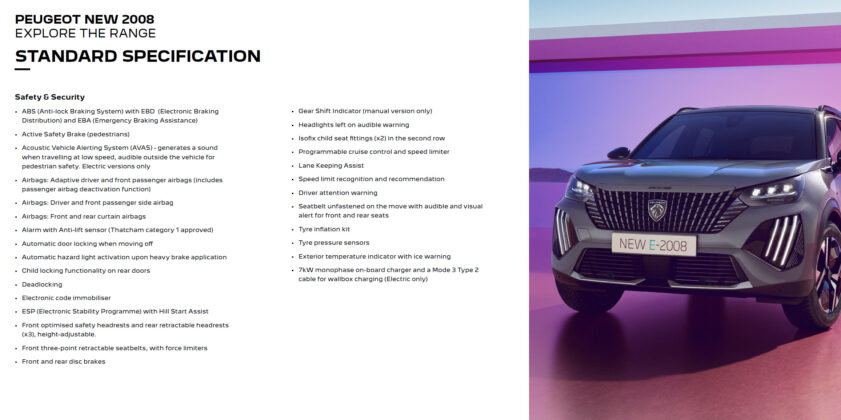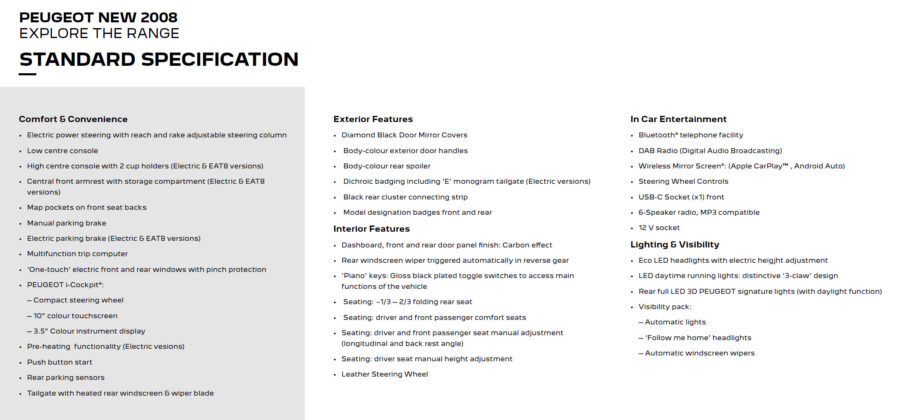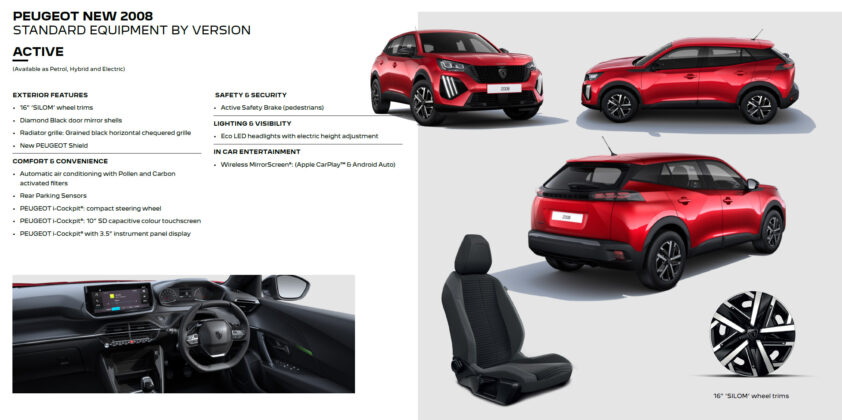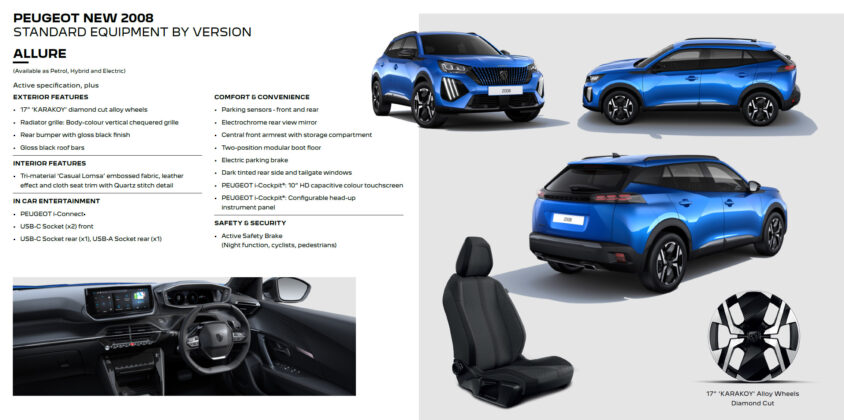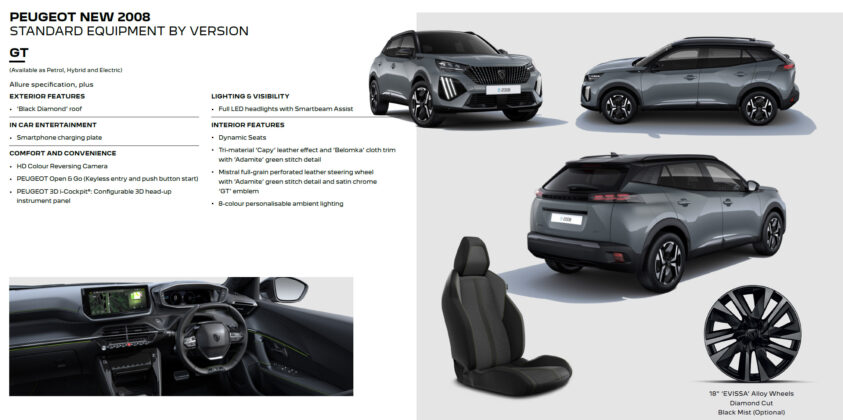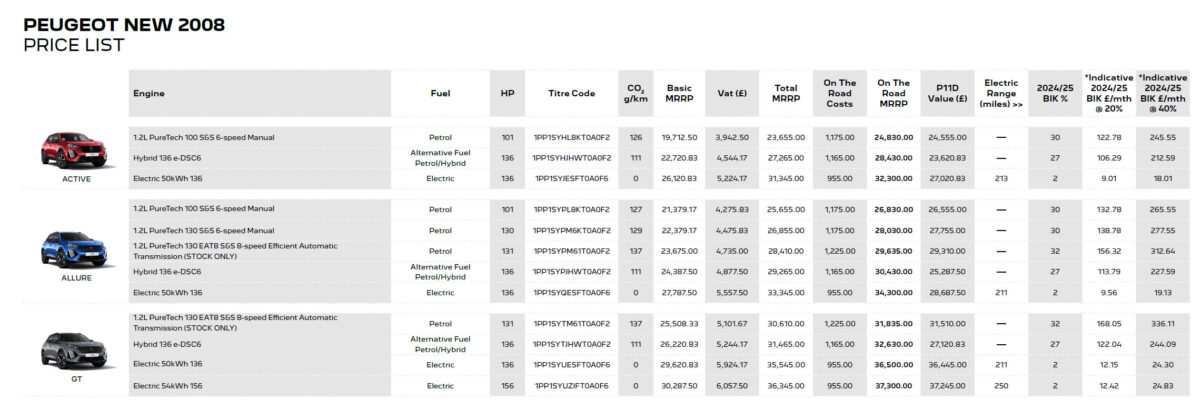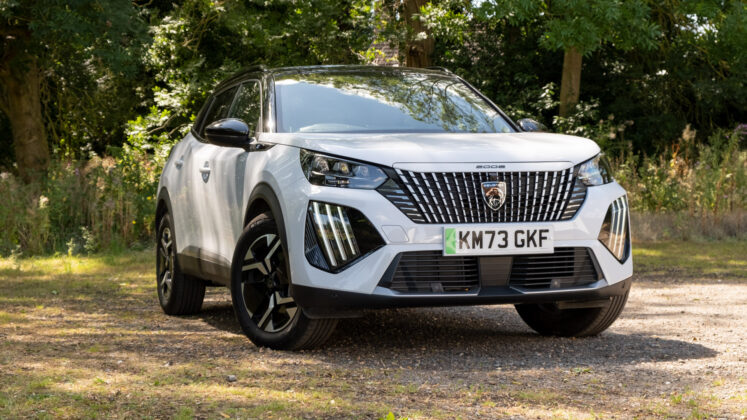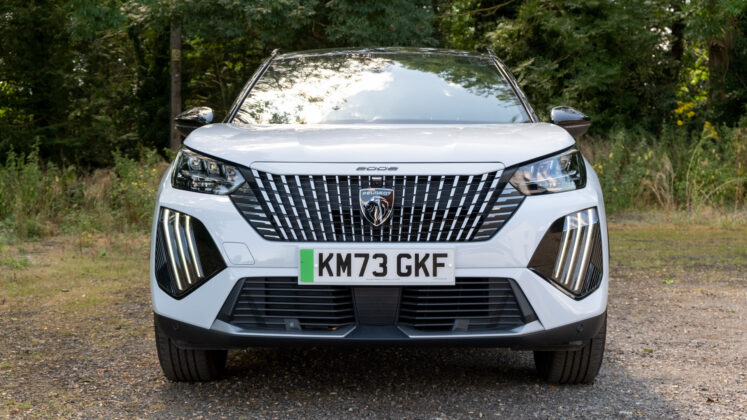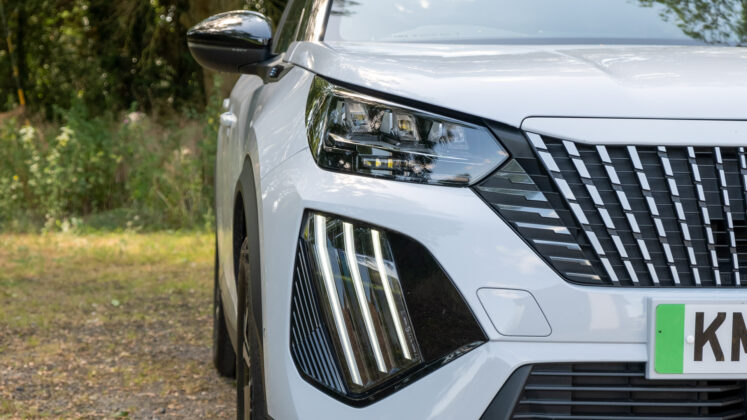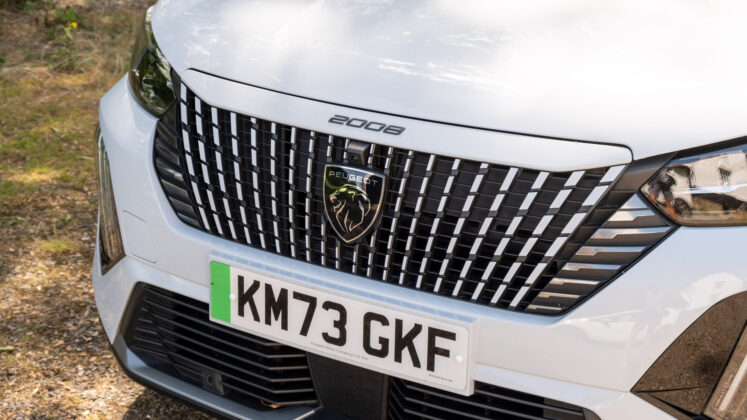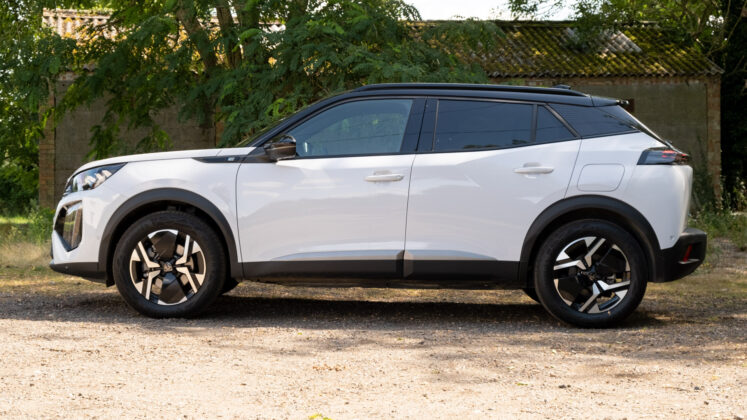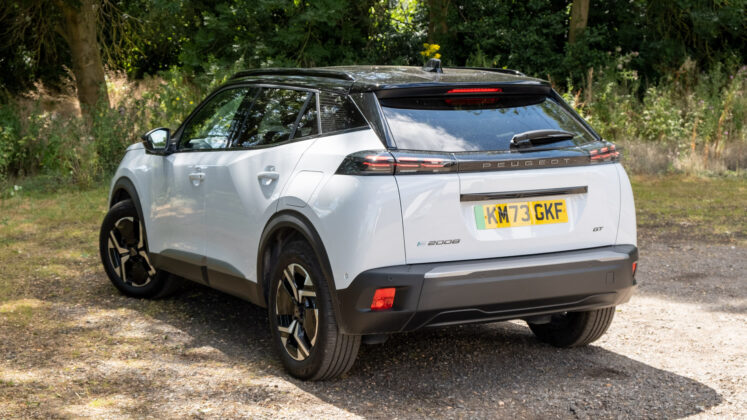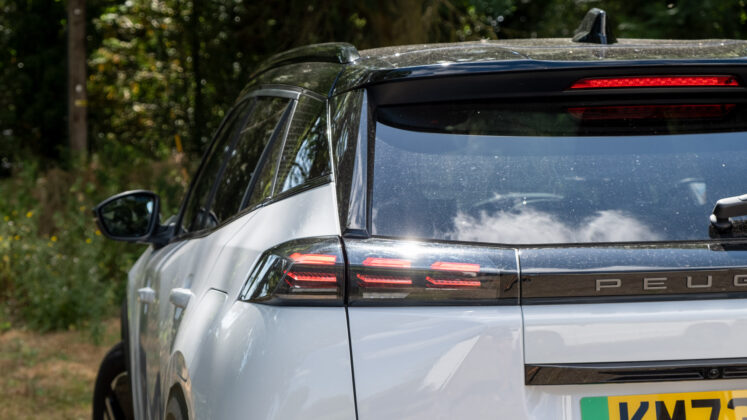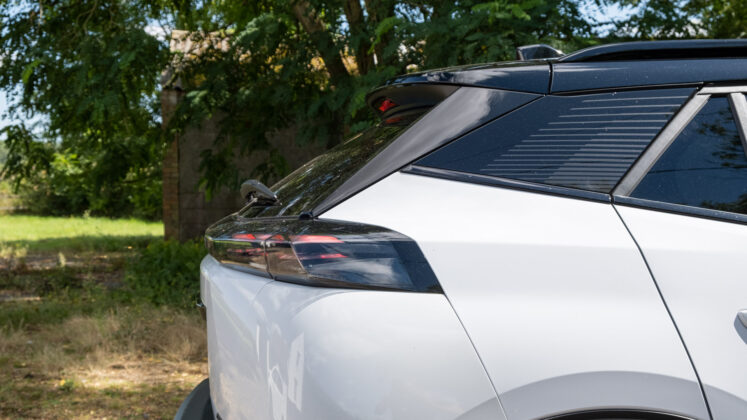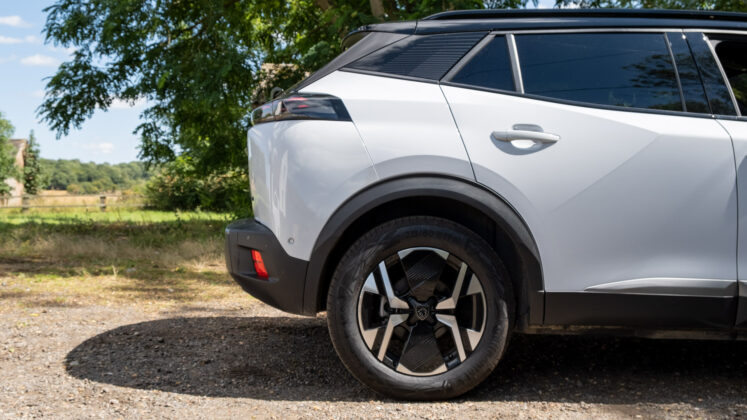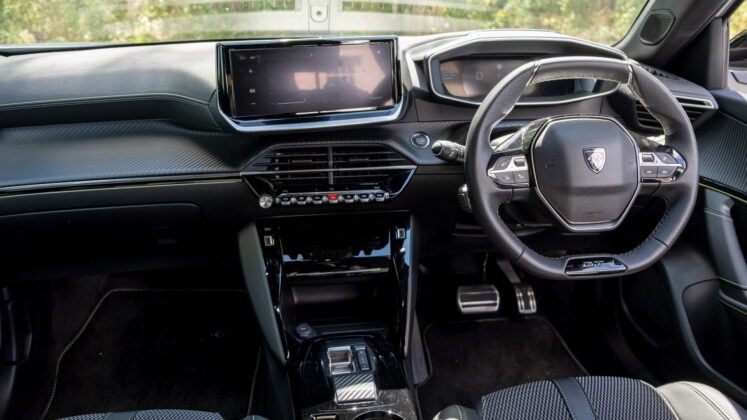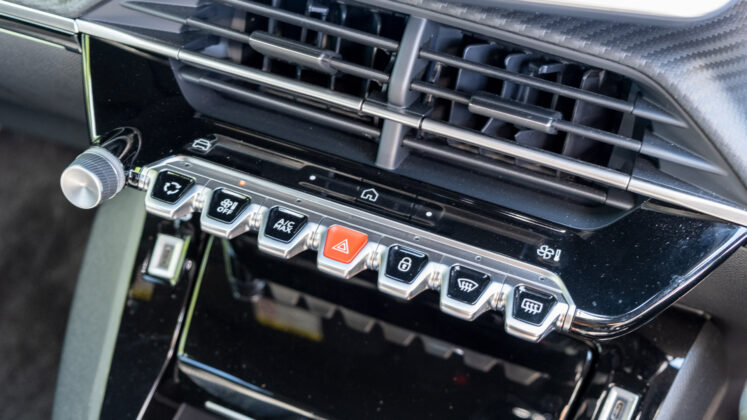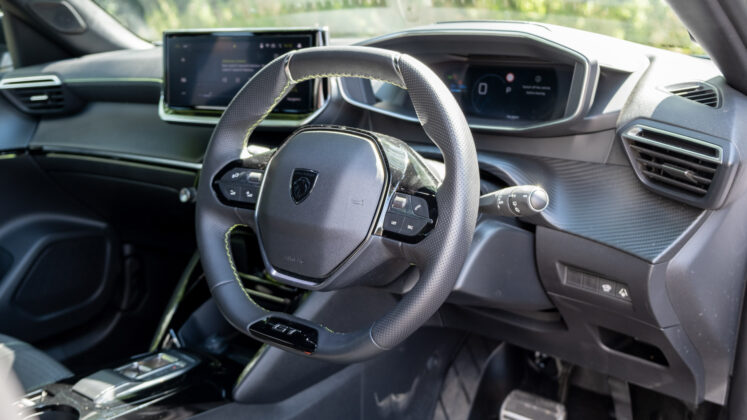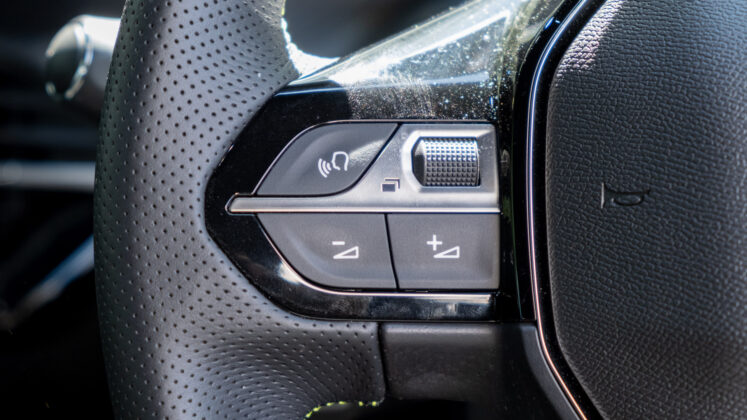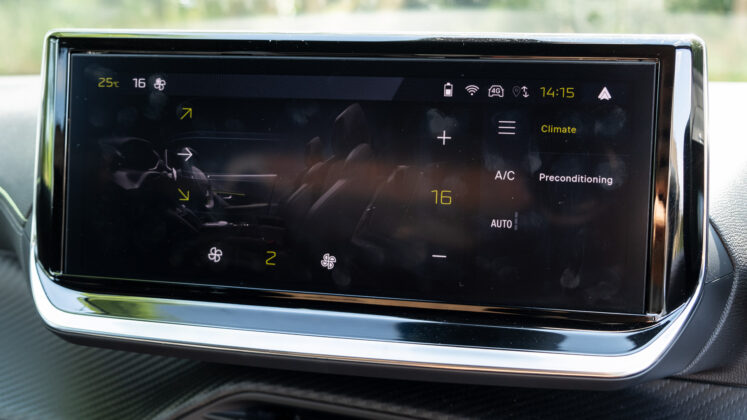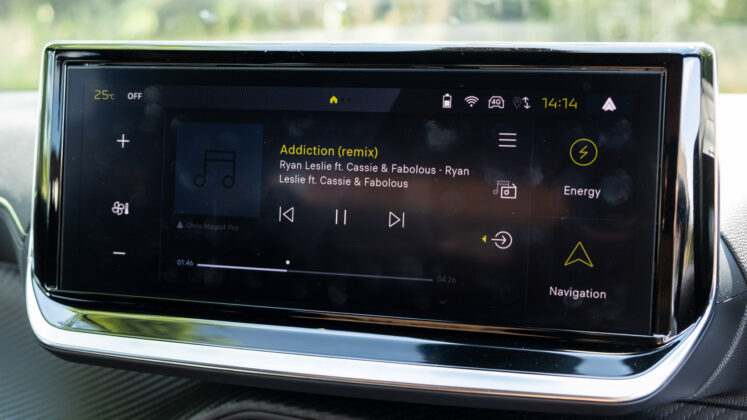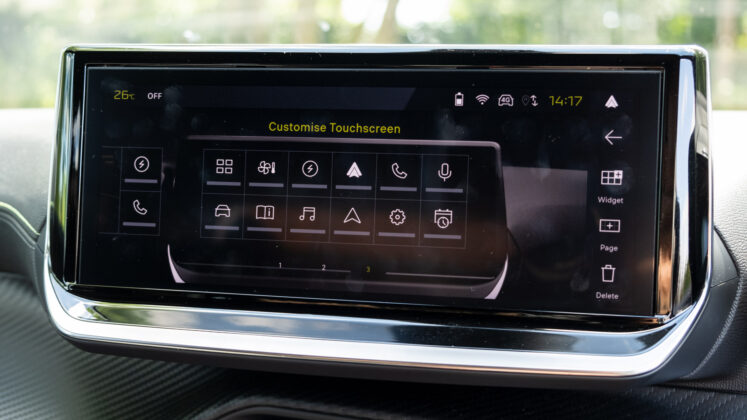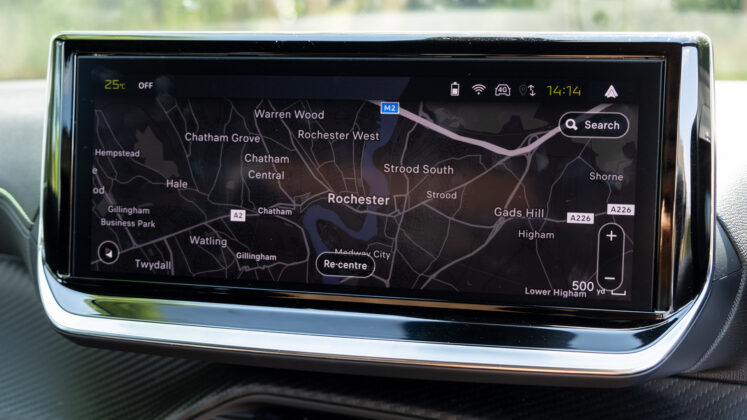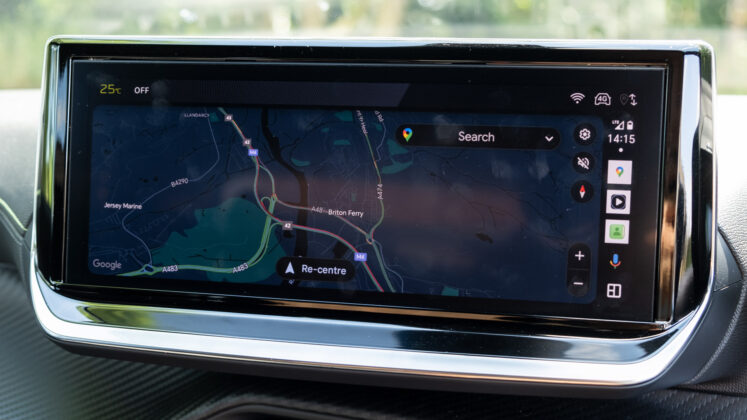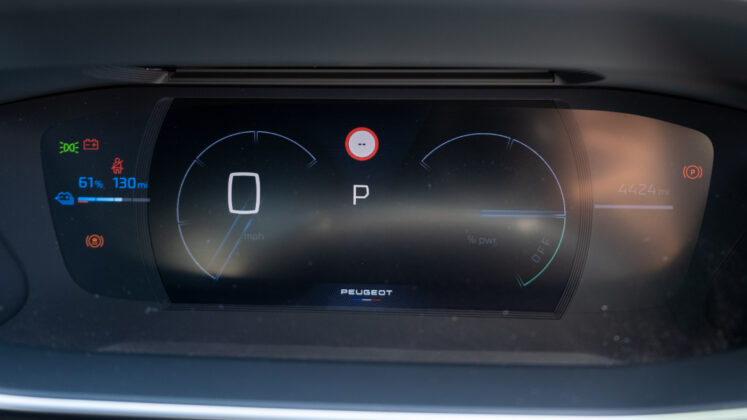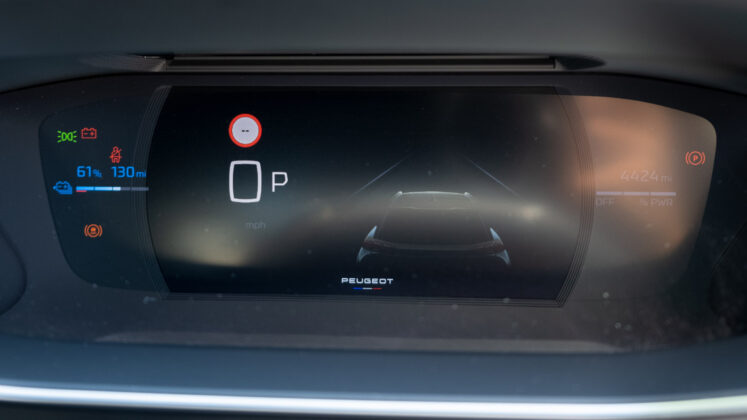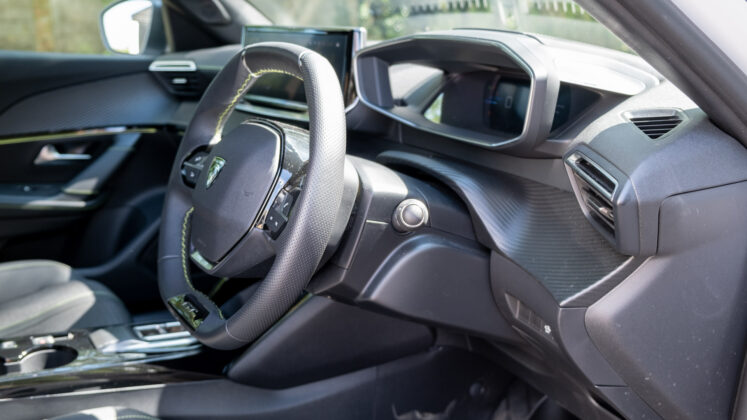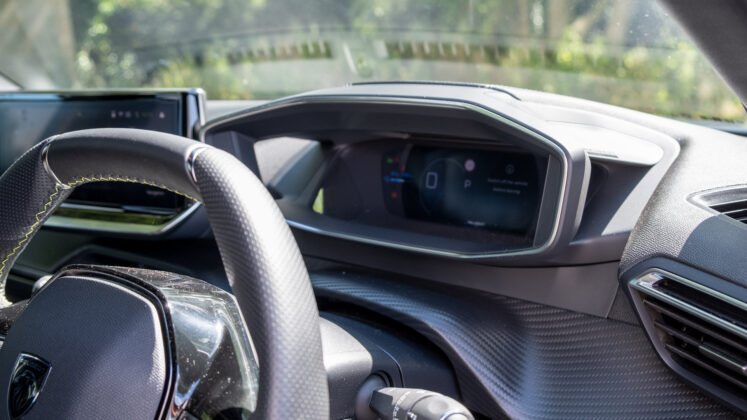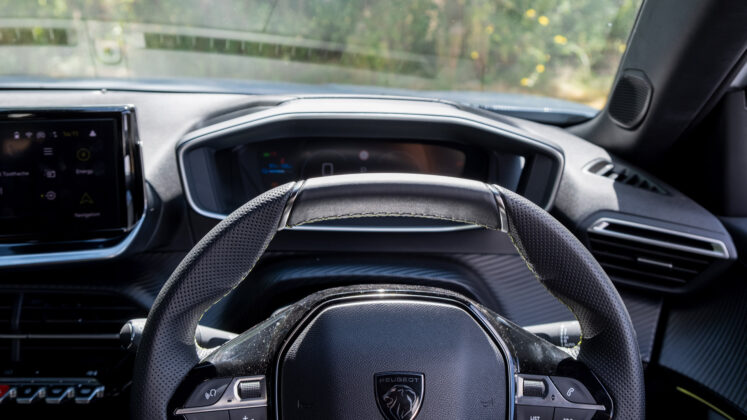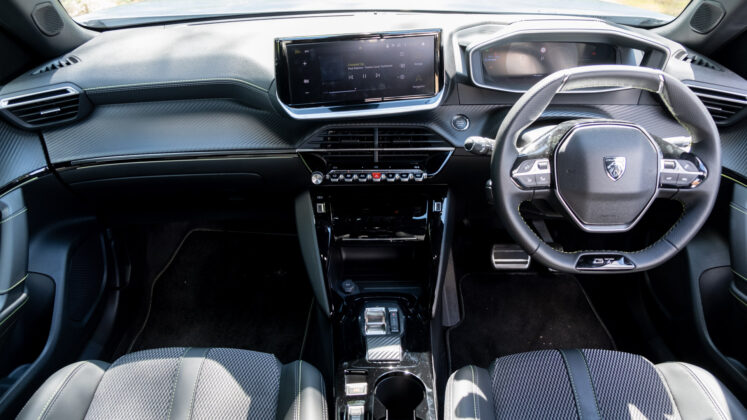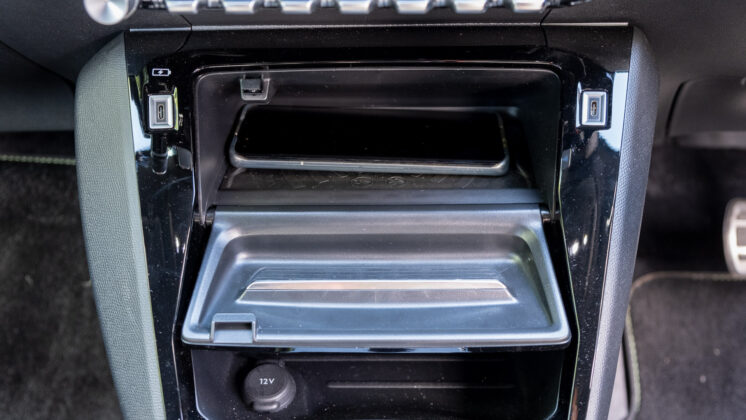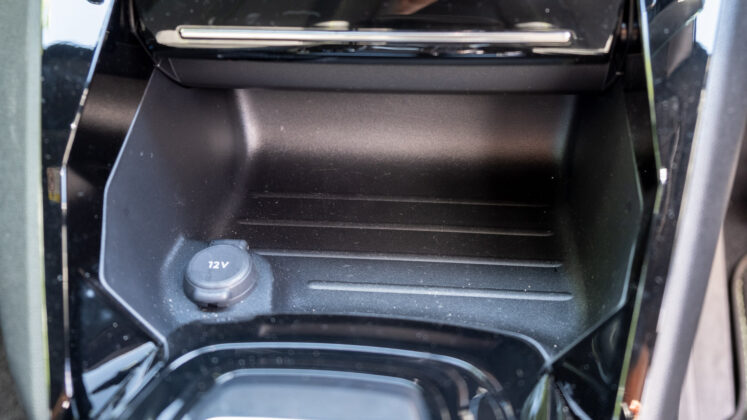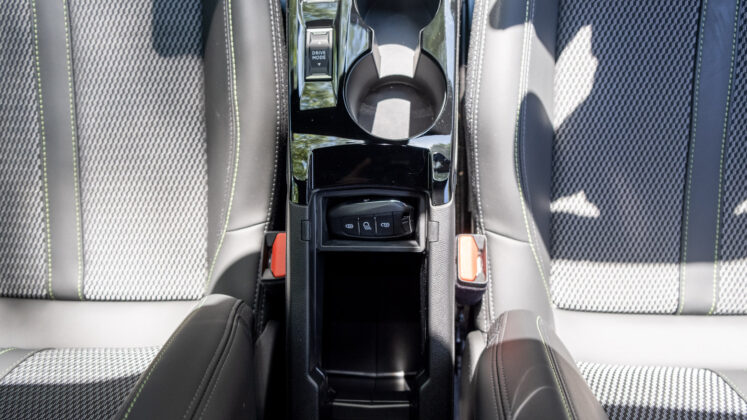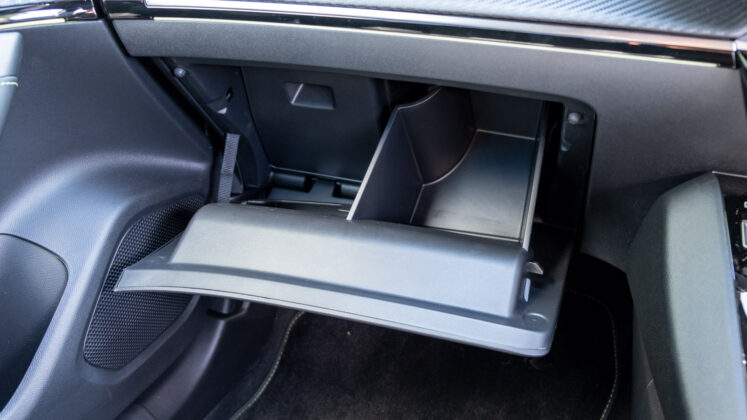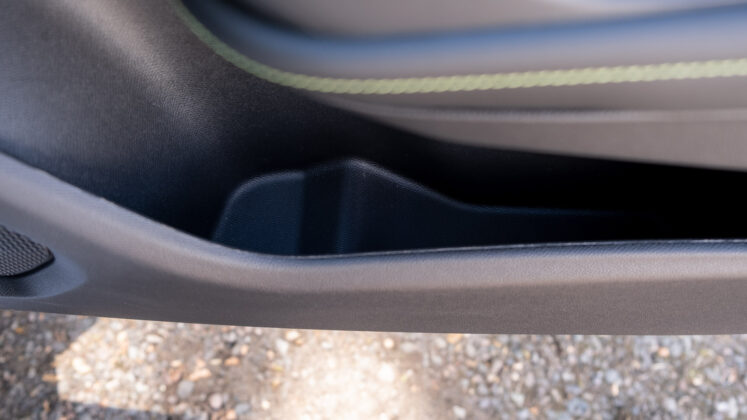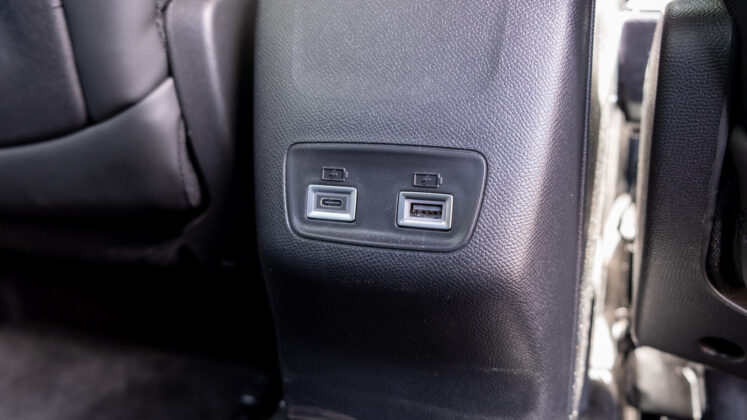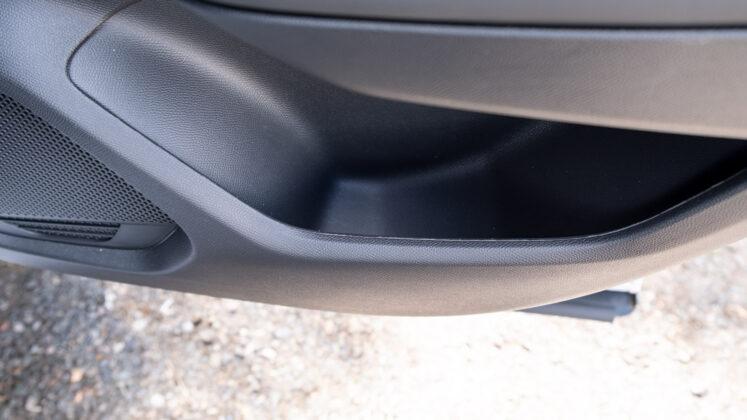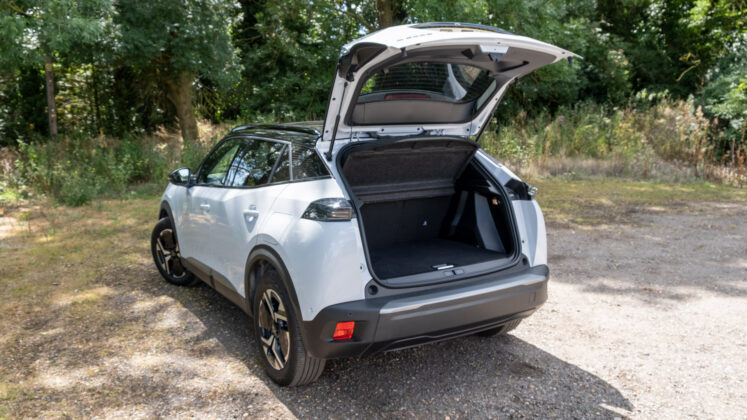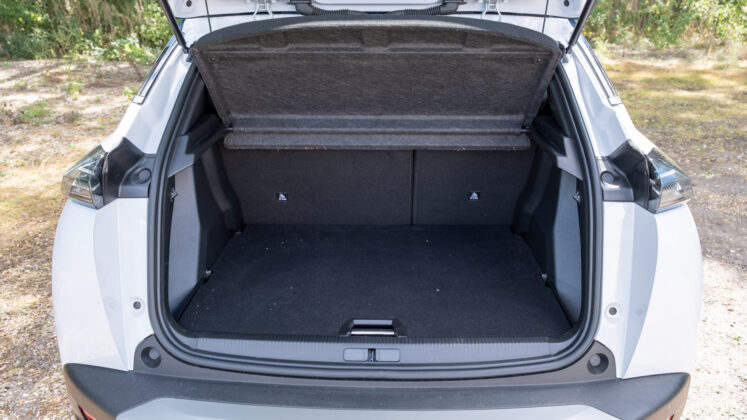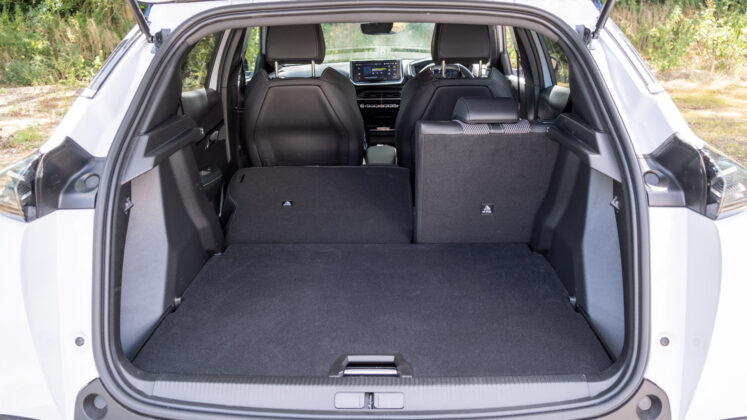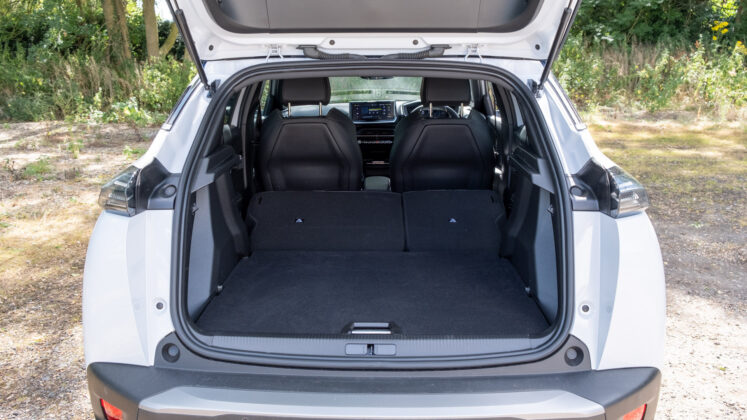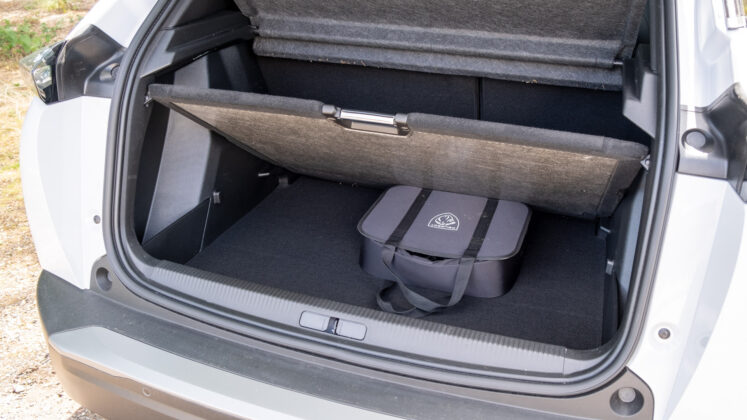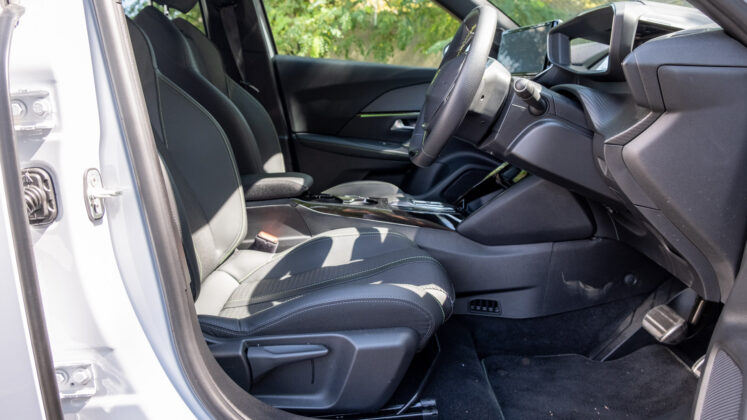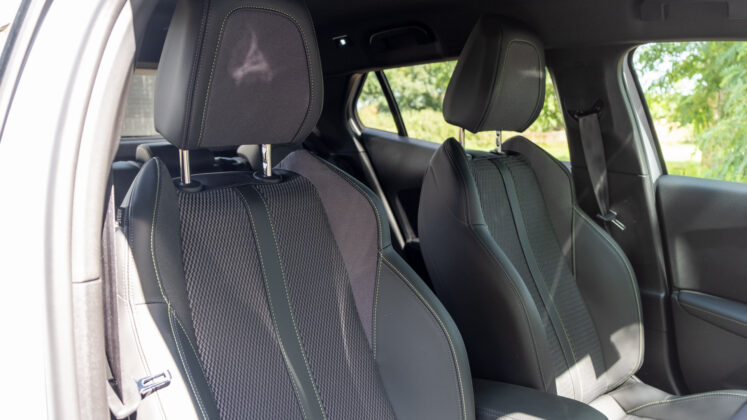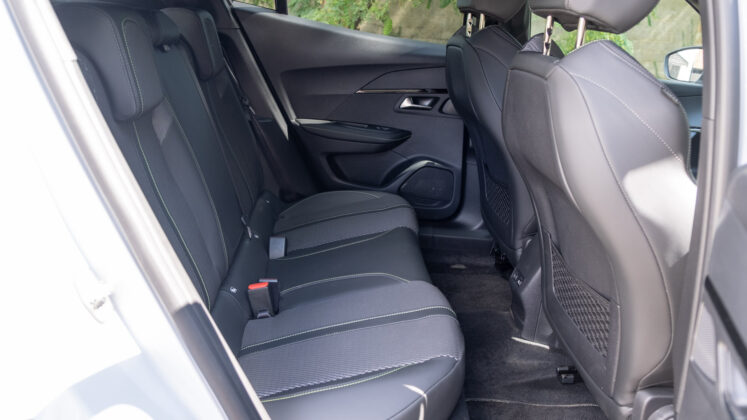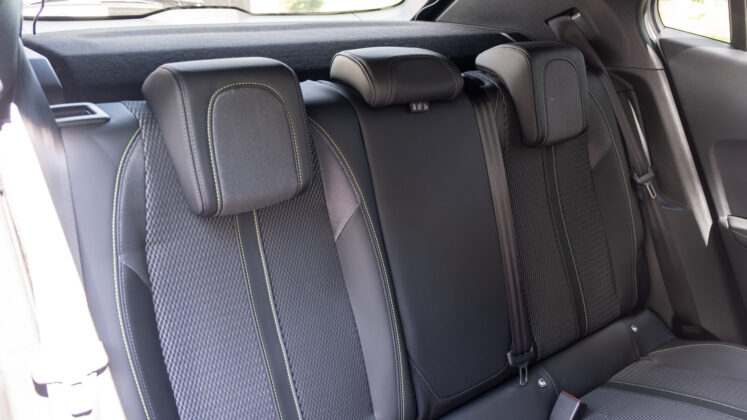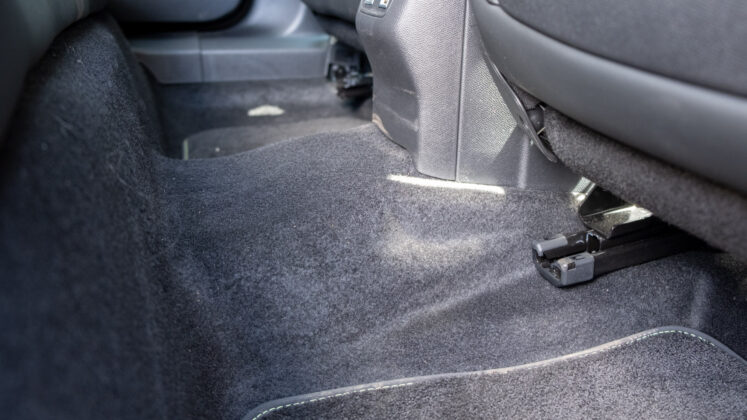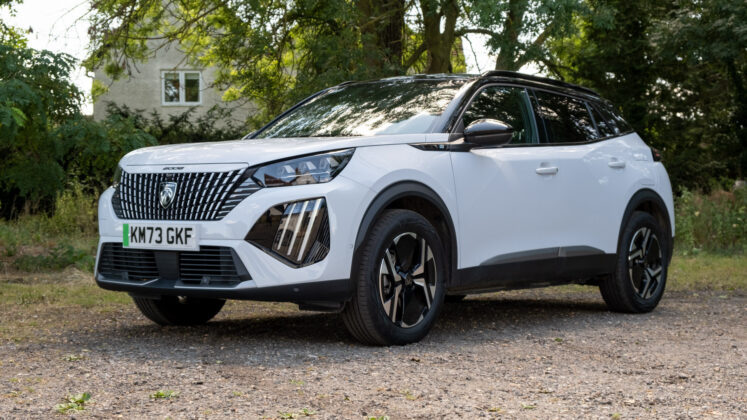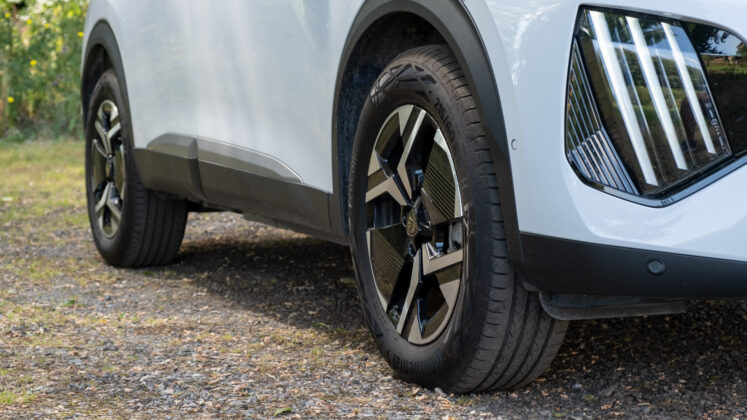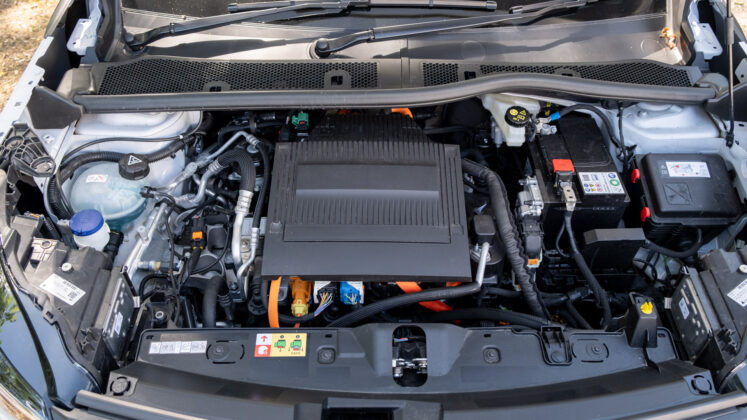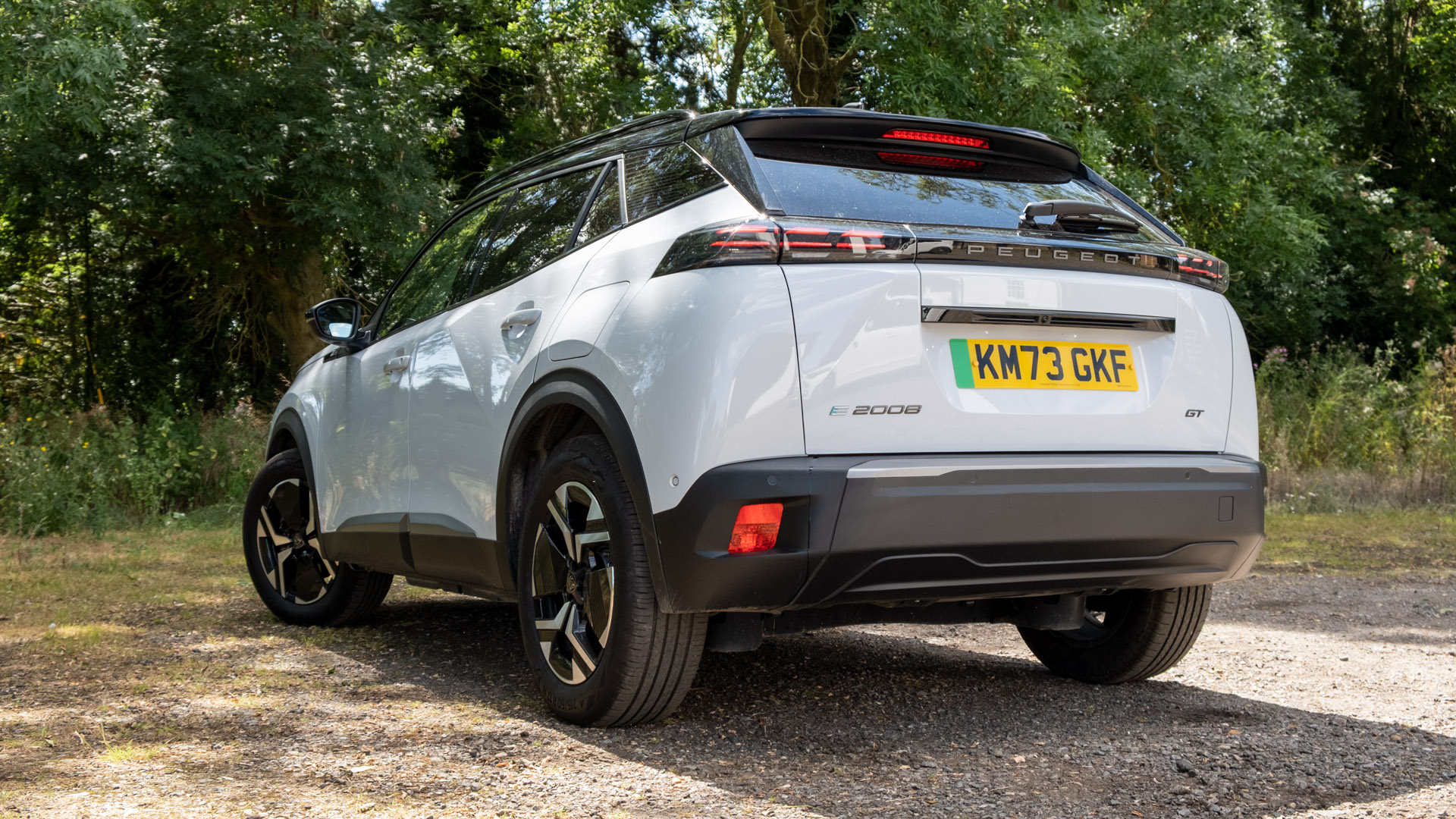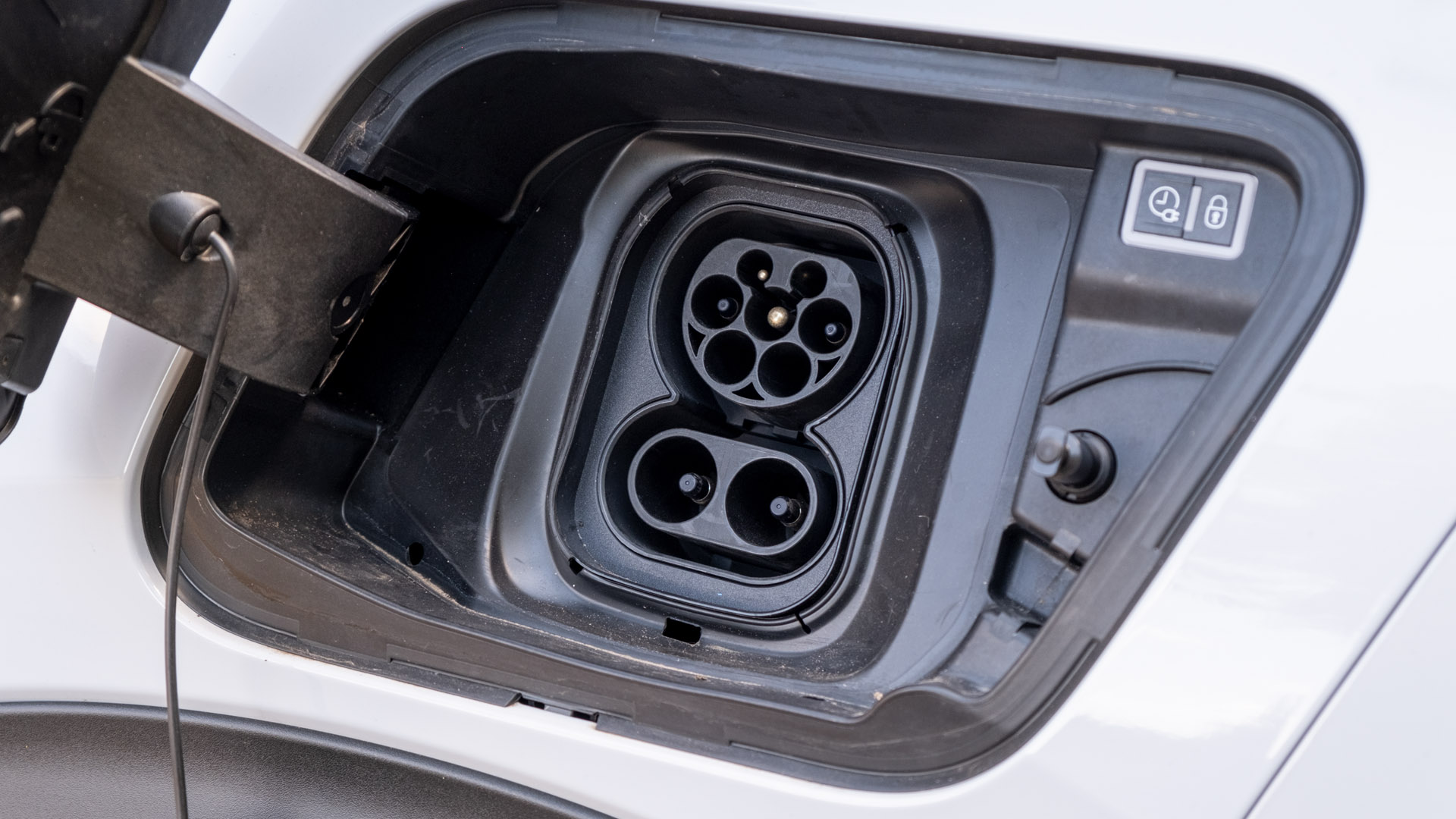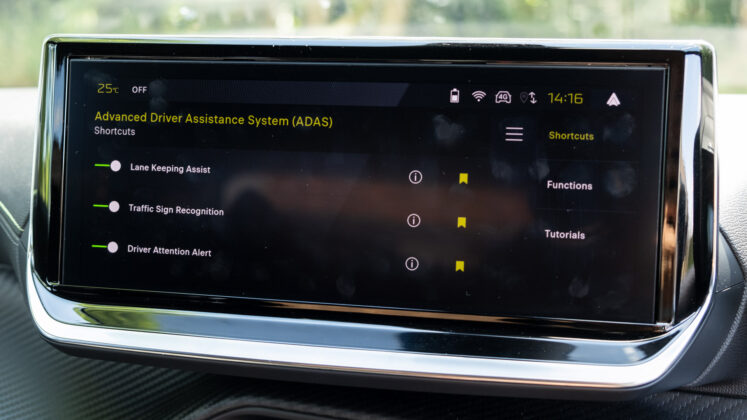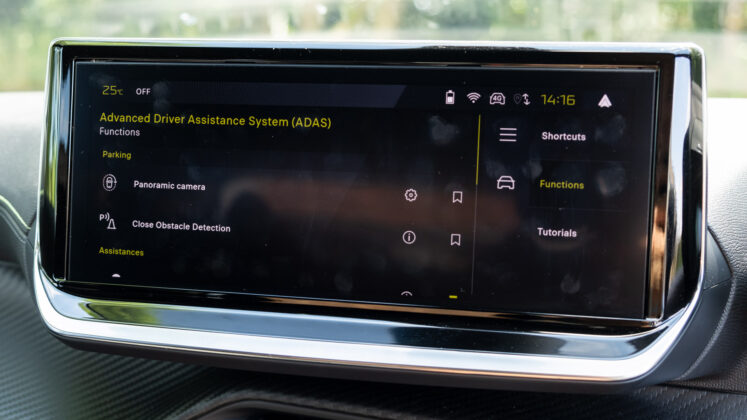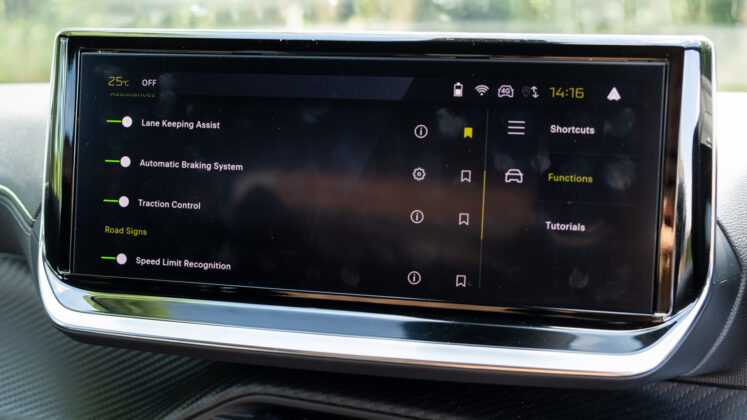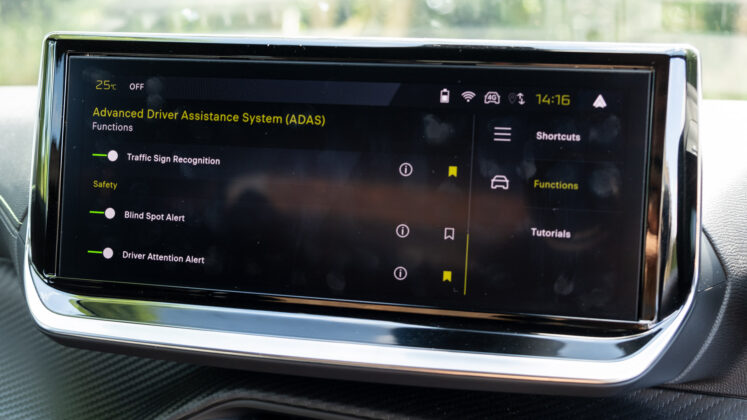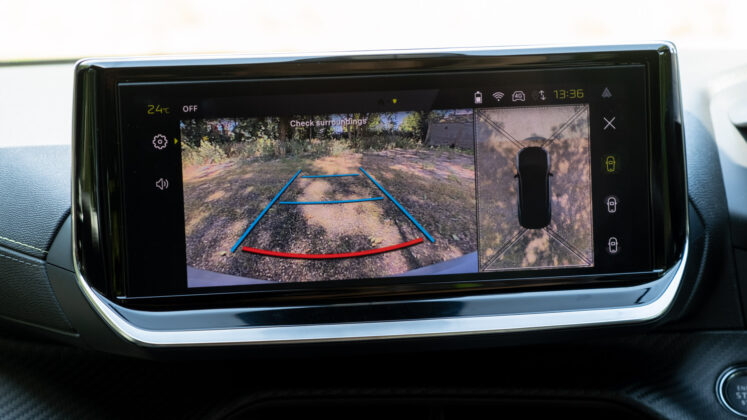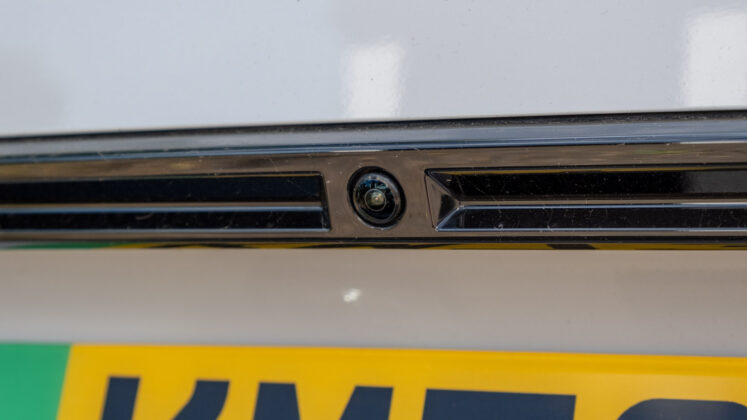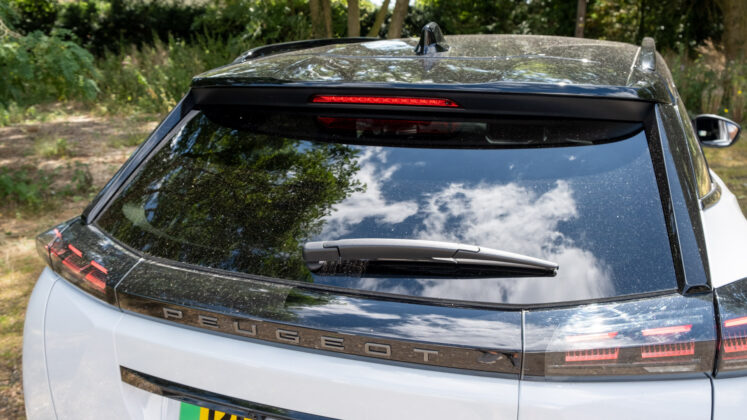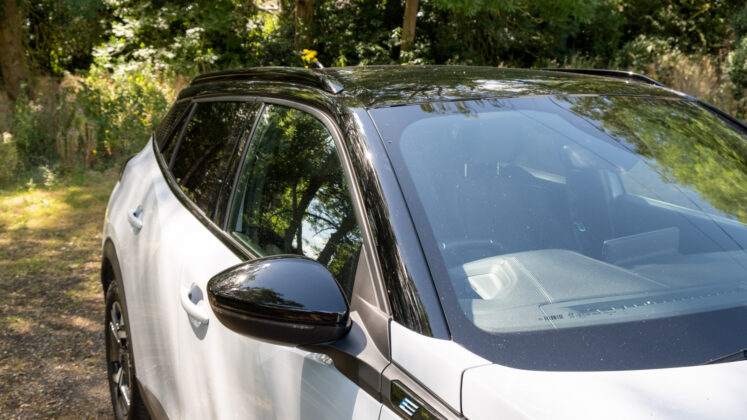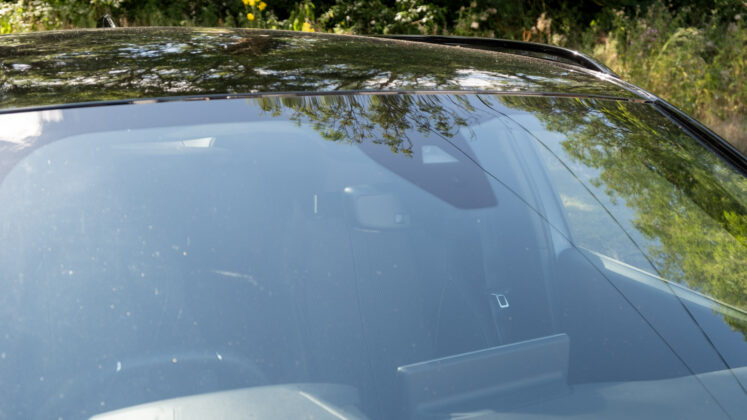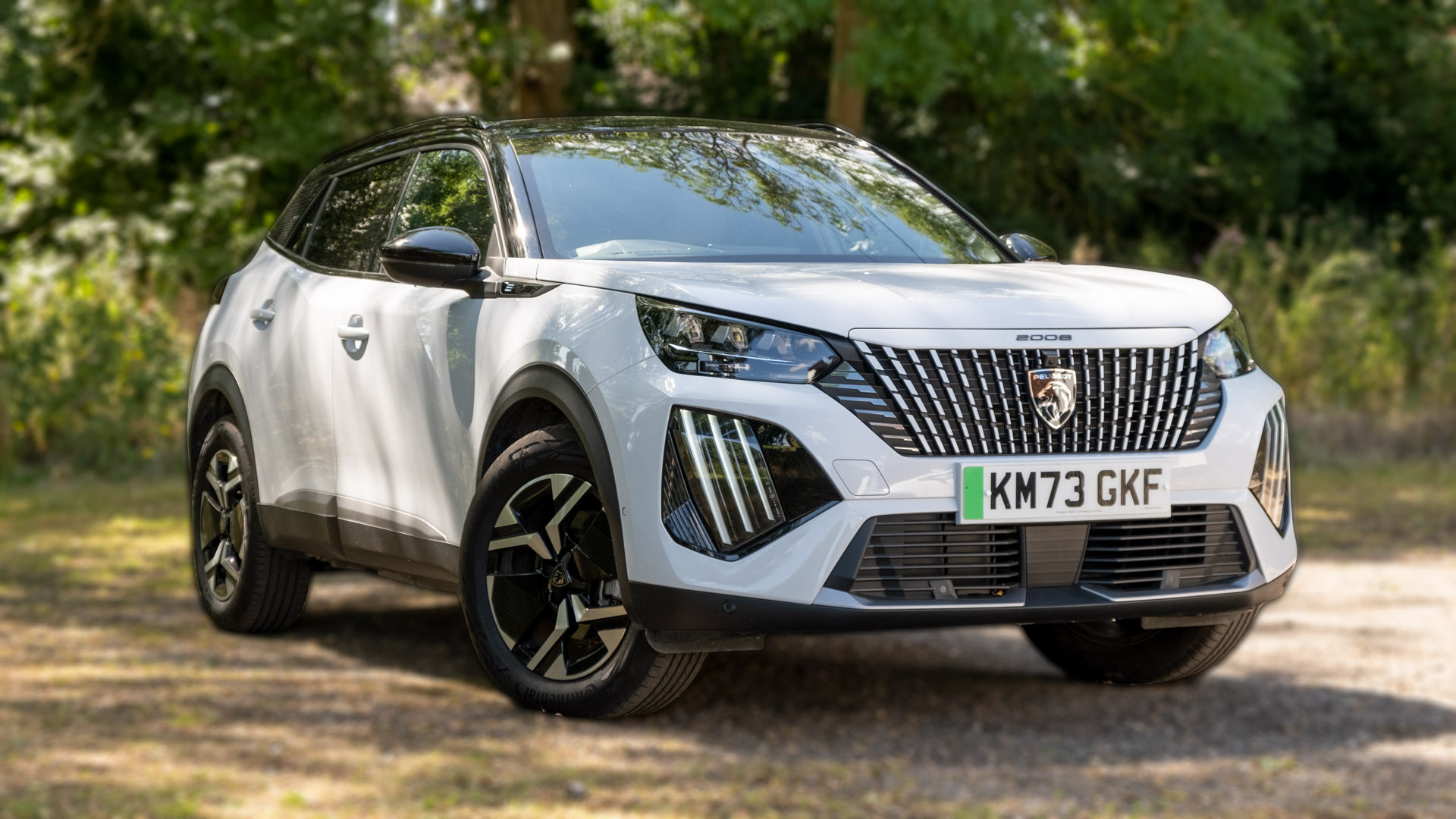When we reviewed the Peugeot E-2008 in 2021, we found it to be a very stylish SUV that provided prospective buyers with an alternative to other electric SUVs on the market. To help it compete with its modern rivals, Stellantis, the automaker, upped the ante by including a slightly larger battery and further refined its already-alluring design.
If you’d prefer to watch a review of the Peugeot e-2008, head on over to our YouTube channel.
Peugeot e-2008 price & competition
At the time of writing and in the UK, the new E-2008 is available in three trims that all come fitted with a 50 kWh battery pack: Active from £32,300, Allure from £34,300 and GT from £36,500. The newer and larger 54 kWh battery pack is only available in the top-spec GT trim, which costs £37,300 without including any options.
A breakdown of the differences between the trims can be found below (click to expand):
Find the best Peugeot E-2008 deals
In terms of the alternatives, there are quite a few all-electric SUVs to consider: the Fiat 600e from £29,995; MG ZS EV from £30,495; Citroen e-C4 from £30,569; Citroen e-C4 X from £31,610; Kia Soul EV from £32,875; Hyundai Kona Electric from £34,995; Jeep Avenger from £35,700; Peugeot e-2008 from £36,500; Kia Niro EV ‘2 64’ from £37,325; BYD Atto 3 from £37,596; Vauxhall Mokka-e from £37,610; Skoda Enyaq iV from £40,585; Volkswagen ID.4 from £42,640; Hyundai Ioniq 5 from £43,445; BMW iX1 from £44,560; Tesla Model Y from £44,990; Kia EV6 from £45,275; Peugeot e-3008 from £45,850; Audi Q4 40 e-tron from £50,745; BMW iX2 from £51,615; BMW iX3 from £62,865; and the Jaguar I-Pace from £66,350. You’ve also got the MG5 EV, an all-electric estate that starts from £30,995.
Read next: Kia Niro EV review: An upgraded e-Niro?
Peugeot e-2008 exterior review
The previous generation E-2008 was a standout in terms of its exterior design; it really set itself apart from rival alternatives. Yet, the new generation model is, in our opinion, even more stylish. This is largely thanks to its frontal profile that’s received a little bit of an uplift. The three-claw design, combined with the accentuated headlights and dazzling front grille make the Peugeot an even more attractive SUV.
There are 16″ steel wheels in the Active and 17″ diamond cut alloys in the Allure and GT (18″ rims are available as an option in the GT). In terms of your colour options, the metallic Selenium Grey comes fitted as standard, while Cumulus Grey, Nera Black, Selenium Grey, and the pictured Okenite White cost an additional £750. The premium metallic Elixir Red and Vertigo Blue will set you back an additional £950 instead. A Nera Black roof comes fitted as standard on the GT trim only.
Read next: Audi Q4 e-tron review: Best electric Audi?
Peugeot e-2008 interior review
Inside, the cabin is still exquisitely designed; from the stitching work on the upholstery, the materials used on the dashboard to the finish of the door frames. Granted, it won’t compete with more premium alternatives, but it still looks and feels the part.
Better still, Peugeot has retained a practical interior design, with a flurry of physical buttons on the steering wheel, the centre console and the dashboard; there are a few physical shortcuts that give you quick access to certain key settings, such as the climate controls. It is a shame, however, that the i-Toggles that are included in the likes of the E-308 and 408 aren’t present – the small customisable touchscreen display allows for quick shortcuts to certain areas of the infotainment system.
As for the infotainment system, there is a responsive and vivid 10” touchscreen display, which is slightly angled towards the driver making it easier to use. It’s great to see that both Android Auto and Apple CarPlay are supported over a wired and wireless connection. However, it’s rather surprising and somewhat shocking that only a Standard Definition (SD) display is fitted in the Active trim. Should you want a High Definition (HD) display you’ll need to shell out an additional £850 or opt for the Allure or GT trims instead.
Equally, some might be disappointed to know that the entry-level trim has a part digitalized 3.5″ instrument cluster, with it moving to a customisable and fully digital display in the Allure and GT models. The latter trim also has a 3D design that gives some extra depth, but unlike other Peugeot vehicles that we’ve reviewed, one can’t disable the effect via the infotainment system.
That aside, it is a shame that turn-based navigation data from Android Auto and Apple CarPlay isn’t fed through to the driver’s display, and that there is no Head-Up Display (HUD) in the more expensive trims or available as an option.
The omission of a HUD could be due to the positioning of the instrument cluster, which sits in-between the standard position of a driver’s display and the HUD. This might seem like clever thinking by the manufacturer, however, does bode an issue with visibility of the instrument cluster – notably in the Allure and GT trims with their accentuated i-Cockpit design. Due to the compact steering wheel and the elevated display, it can sometimes be hard to see what’s being displayed, such as the speedometer. In our case, we found it to be bearable, but it’s very much dependent on how you sit and where you position the steering wheel.
Regarding its audio system, there’s a six-speaker system that comes fitted as standard on all the trim levels. Unlike some of Peugeot’s other vehicles, the Focal system cannot be added as an option, which is quite disheartening for budding audiophiles. If you’d like to hear how the system performs, watch our detailed review on YouTube.
Peugeot e-2008 storage review
In terms of storage within the cabin, the E-2008 has a few areas to store your valuables. At the front, within the small retractable compartment that serves as a phone holder, you’ll find a non-slip area, which in the Allure and GT trims doubles up as a wireless phone charger. This, however, will cost you an additional £120 in the Allure trim – quite cheeky from the manufacturer, given the vehicle’s asking price.
Just below, you’ll find another storage area and a 12V socket. A singular USB-C port located at the top of the centre console, which is used to connect to the infotainment system and provide charge, is fitted as standard across the trim range. A second Type-C port used for charging only is available in the Allure and GT trims. There’s also a Type-C and a Type-A port at the rear of the centre console.
Further down the centre console, there are two cupholders and a compartment within the centre armrest; a small removable tray serves as a useful place to store your wireless key.
As for the glove box, it’s disappointing that it’s not been optimised for right-hand drive vehicles. Thankfully, the front door bins are large enough to accommodate a 500ml bottle alongside a wallet or purse, while the rear two are a little smaller.
It’s unfortunate, however, that the door bins and the areas within the centre console have not been lined in fabric, meaning loose change and keys will be heard rattling around while traversing uneven terrain. There’s also no pulldown armrest compartment at the rear of the cabin for extra comfort.
Its boot capacity is sizable, the Peugeot E-2008 offers 434 litres with the seats up and 1,467 litres with them folded flat; coincidentally these are identical figures to its predecessor.
Here’s how it stacks up to some of its competitors: Tesla Model Y (854/2,100 litres); Peugeot e-3008 (588/1,663 litres); Jaguar I-Pace (656/1,453 litres); VW ID.5 (549/1,561 litres); VW ID.4 (543/1,575 litres); Hyundai Ioniq 5 (520/1,587 litres); BMW iX3 (520/1,560 litres); Audi Q4 e-tron (520/1,490 litres); Genesis GV60 (432/1,550 litres); BMW iX2 (525/1,400 litres); BMW iX1 (490/1,495 litres); Citroen e-C4 X (510/1,360 litres); Kia EV6 (490/1,300 litres); MG ZS EV (448/1,375 litres); Kia Niro EV (475/1,392 litres); Hyundai Kona Electric (466/1,300 litres); BYD Atto 3 (440/1,338 litres); Kia Soul EV (315/1,339 litres); Citroen e-C4 (380/1,250 litres); Peugeot e-308 (361/1,271 litres); Fiat 600e (360/1,231 litres); Smart #1 (421/989 litres); Jeep Avenger (355/1,053 litres); Vauxhall Mokka-e (310/1,060 litres); GWM Ora 03 (228/858 litres). As for the MG5 EV estate, it offers 479 and 1,367 litres, respectively.
In terms of practicality, the Peugeot E-2008 has a hatchback design, with 60:40 rear-split folding seats, a flat loading bay and a sizable underfloor compartment that’s large enough to accommodate the vehicle’s charging cables. Unfortunately, an electric tailgate isn’t available as an option, which might be a deal-breaker for certain individuals, as the boot lid itself is surprisingly heavy.
Unlike some of its rivals, the E-2008 doesn’t come with a frunk (a storage area at the front). This is, in part, due to the vehicle not being built from the ground up as an EV.
Reax next: Smart #1 review: The best new EV?
Peugeot e-2008 comfort review
Aside from storage, the E-2008 has comfortable and accommodating seats. They’re not as padded cushiony soft as the ones found in the e-C4 or e-C4 X but they still provide excellent support to both front and rear passengers.
Headroom and legroom is a non-issue at the front of the cabin, while at the back it isn’t too restricted either. 6-foot (182cm) individuals will be able to sit without too much discomfort, although, the seats are diagonally wedged meaning quad muscles might be a little tired on longer journeys. It’s also disheartening that Peugeot hasn’t fully optimised the rear footwell; the nonsensical transmission tunnel encroaches legroom, namely for the rear middle occupant.
In terms of seat adjustments, the front two are manually operated only, with lumbar support for the driver fitted as standard. Should you want electric controls and heated front seats you’ll have to splash out £500 on an option, which is only present on the GT trim. Heated front seats are available in the Active and Allure trims for an additional £200. Should you want a sunroof, it’ll cost you an additional £750 in the Allure and GT trims; it’s not available in the Active model.
Find the best Peugeot E-2008 deals
What is great to see, however, is the hexagonally-shaped steering wheel. It’s fitted as standard across the trim range and we previously noted its unique form factor in the e-208, e-308, e-3008 and 408 Hybrid. Indeed, its compact design makes it easy to grip and entices a degree of connection with the front axle. As for cabin noise, it’s among one of the quietest cabins that we’ve tested, let alone for an SUV of its price and category.
Read next: Citroen e-C4 review: Most comfortable SUV?
Peugeot e-2008 performance review
While it does have a serene cabin experience, the E-2008 does have a stiffened suspension setup, especially when compared to the floaty configuration found on the Citroen e-C4 and e-C4 X. As a result, when you’re pottering around town you’ll be able to feel some of the anomalies, speed bumps and potholes. Make no mistake, however, it’s not as stiff as some of its rivals, but one might have expected it to be a little more comfortable.
The advantage of having a planted feel is that the driving experience is a bit more engaging. Indeed, the vehicle’s pseudo-MacPherson strut setup at the front and Panhard bar rear train at the back helps keep the SUV from seesawing around on winding roads. Combined with its compact steering wheel, the E-2008 is plenty of fun to drive’ with that said, it won’t dethrone the likes of the BMW iX1, the iX2, the iX3, the Jaguar I-Pace and the Audi Q8 e-tron.
Speaking of which, the E-2008 isn’t as powerful when compared to more expensive alternatives. This is because the Peugeot has a singular motor planted on the front axle only. In the 50 kWh model, it produces 100 kW of power (136 hp) and 260 Nm of torque, while in the 54 kWh model, you’ve got 115 kW of power (156 hp) and 260 Nm of torque. Using Racelogic’s Performance Box Touch we had the 54 kWh variant tested from 0-20mph in 2.36 seconds, 0-30mph in 3.56 seconds; 0-60mph in 8.6 seconds; 50-70mph in 4.46 seconds and recorded a peak acceleration of 0.4g. Top speed is limited to 93mph.
Buy a car phone mount on Amazon (Affiliate)
Despite its lack of power in a straight line, it should suffice for the vast majority of consumers, as it’s not aimed at those who want an electric rocketship. What is of greater importance, however, is its electric range. Peugeot claims that one should be able to attain 201-232 miles with the 50 kWh model, and 227-270 miles in the 54 kWh variant. In our mixed driving tests of the latter model, we netted a respectable 205-225 miles of electric range. This marks a notable improvement over the previous generation model, which housed a 50 kWh battery pack and attained 140-160 miles in our mixed driving tests.
It should be noted that the press vehicle on review had the optional £400 heat pump installed. We’ve found this usually helps get a longer electric range as the vehicle becomes more efficient in heating the cabin by recycling the heat that is dissipated from the battery pack. It is therefore disappointing that this does not come fitted as standard across the E-2008 line; many of its competitors have it fitted.
Here’s how it compares to some of its competitors: 325 miles in the VW ID.5; 275-295 miles in the Peugeot e-3008; 270-290 miles in the Smart #1; 250-280 miles in the Tesla Model Y Long Range; 260 miles in the Kia Soul EV (with heat pump), Audi Q4 e-tron, and VW ID.4 (no heat pump); 240-260 miles in the Kia EV6 RWD; 240-250 miles in the Jaguar I-Pace; 230-250 miles in the Hyundai Ioniq 5 AWD and MG ZS EV Long Range; 210-230 miles in the Genesis GV60 Sport+, MG5 EV and BYD Atto 3; 205-225 in the Hyundai Kona Electric and Kia Niro EV; 210-220 miles in the Mercedes EQA 250; 200-220 miles in the Fiat 600e, Jeep Avenger and Genesis Electrified GV70; 180-200 miles in the Citroen e-C4, e-C4 X and Ford Mustang Mach-E; 170-190 miles in the Peugeot e-308; 150-170 miles in the Vauxhall Mokka-e; and 140-160 miles in the GWM Ora 03.
To be as efficient as possible while on the move, you’ll want to enable B-mode, which can be done by pressing the button located on the centre console. This will help decelerate the vehicle when you lift off the accelerator pedal. However, unlike its competitors, it won’t give you a full one-pedal drive, meaning you’ll still have to resort to using the physical brake pedal when you’re pottering around town.
Of course, one can replenish its 54 kWh battery pack at a much more rapid rate by plugging it in. The E-2008 can take up to 100 kW of input charge, meaning it can go from 20-80% in 30 minutes when connected to an appropriate DC charge point. Using a regular 7 kW wallbox it’ll take 7hrs 30mins to go from 0-100%. One can reduce this time by spending an additional £360 to upgrade the onboard charger to 11 kW, which is useful if you have access to a three-phase power supply. As for the 3-pin wall socket, it will take 24hrs instead.
Read next: Tesla Model Y review: Best electric SUV?
Peugeot e-2008 safety review
At the time of writing, the new E-2008 has not been tested by Euro NCAP, but the older-generation model was tested in 2019 and it achieved 4/5 stars, scoring 91% in Adult Occupancy, 84% in Child Occupancy and 68% in Safety Assist. One might assume a similar rating with the newer model.
It’s great to see that there are a plethora of driver assistance systems. As standard on all trim levels, you’ll find the following: Lane Keeping Assist, Speed limit recognition and recommendation, Driver attention warning, Active Safety Brake (pedestrians), and Programmable cruise control and speed limiter. In the Allure and GT, you also have Active Safety Brake (Night function, cyclists, pedestrians).
Should you not want to have a few of these safety systems in operation, you can easily disable them via a shortcut that can be accessed by pressing the physical car icon on the dashboard. While there’s no physical toggle to disable the likes of Lane Keep Assist, which gets enabled each time you power on the vehicle, it’s still great that you have a quick shortcut to toggle the setting through the infotainment system – shortcuts can be assigned to make it easier to navigate too.
If you want Adaptive cruise control with Stop & Go function and Lane positioning assist you’ll have to opt for the Allure or GT trims and add the Drive Assist Pack Plus for £300. A worthwhile addition as the former system keeps you at a safe distance from the leading vehicle and doesn’t feel jerky either. The latter system is a little hit-and-miss, as it sometimes fails to give you steering support at higher speeds.
Should you want to go one step further, you can add a blind spot monitoring system and front and rear HD cameras for £200 in the GT trim (Parking Pack), or £800 in the Allure (Navigation & Parking Pack).
This brings us to parking, which is relatively easy in the E-2008 thanks to its tight 10.4-meter turning circle. Rear parking sensors come fitted as standard across the trim range, while front sensors are fitted in the Allure and GT models. It’s mind-boggling to think that a reversing camera isn’t included as standard in all the trim levels, but rather is only included in the top-spec GT model. Should you want a better view of your surroundings you’ll need to spend £600 with the Allure and £850 with the Active trim.
As for visibility, it’s good at the side and towards the rear, especially with the inclusion of a rear wiper. However, frontal vision is partially obscured due to the positioning of the rearview mirror; a similar complaint we’ve had of other vehicles from Stellantis.
Read next: Volkswagen ID.5 review: Germany’s best electric SUV?
TotallyEV’s verdict on the Peugeot e-2008
Overall, the Peugeot E-2008 is a stylish and compact electric SUV. It’s fun to drive, includes plenty of useful tech within the cabin and has a good electric range. However, it does fall short of providing a truly comfortable or exhilarating drive. Disappointingly, there are also plenty of features omitted that one might expect to come as standard, and considering the vehicle’s asking price it’s hard to outright recommend over rival alternatives, including those sold by the Stellantis.
Find the best Peugeot E-2008 deals
What do you make of the fully electric 2008? Let us know in the comments section below or via social media; we’re on: YouTube, Instagram, Facebook, X and LinkedIn.

